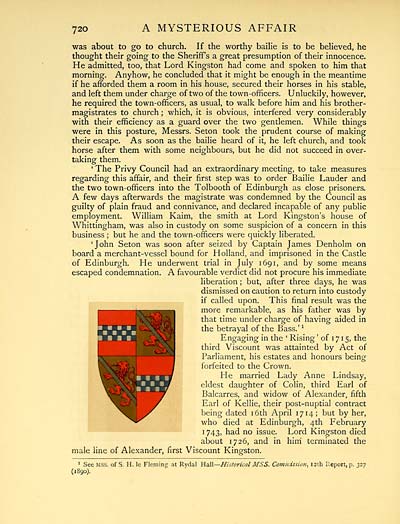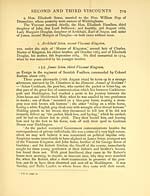Download files
Complete book:
Individual page:
Thumbnail gallery: Grid view | List view

720
A MYSTERIOUS AFFAIR
was about to go to church. If the worthy bailie is to be believed, he
thought their going to the Sheriffs a great presumption of their innocence.
He admitted, too, that Lord Kingston had come and spoken to him that
morning. Anyhow, he concluded that it might be enough in the meantime
if he afforded them a room in his house, secured their horses in his stable,
and left them under charge of two of the town-officers. Unluckily, however,
he required the town-officers, as usual, to walk before him and his brother-
magistrates to church ; which, it is obvious, interfered very considerably
with their efficiency as a guard over the two gentlemen. While things
were in this posture, Messrs. Seton took the prudent course of making
their escape. As soon as the bailie heard of it, he left church, and took
horse after them with some neighbours, but he did not succeed in over-
taking them.
' The Privy Council had an extraordinary meeting, to take measures
regarding this affair, and their first step was to order Bailie Lauder and
the two town-officers into the Tolbooth of Edinburgh as close prisoners.
A few days afterwards the magistrate was condemned by the Council as
guilty of plain fraud and connivance, and declared incapable of any public
employment. William Kaim, the smith at Lord Kingston's house of
Whittingham, was also in custody on some suspicion of a concern in this
business ; but he and the town-officers were quickly liberated.
'John Seton was soon after seized by Captain James Denholm on
board a merchant-vessel bound for Holland, and imprisoned in the Castle
of Edinburgh. He underwent trial in July 1691, and by some means
escaped condemnation. A favourable verdict did not procure his immediate
liberation ; but, after three days, he was
dismissed on caution to return into custody
if called upon. This final result was the
more remarkable, as his father was by
that time under charge of having aided in
the betrayal of the Bass.' 1
Engaging in the ' Rising ' of 1 7 1 5, the
third Viscount was attainted by Act of
Parliament, his estates and honours being
forfeited to the Crown.
He married Lady Anne Lindsay,
eldest daughter of Colin, third Earl of
Balcarres, and widow of Alexander, fifth
Earl of Kellie, their post-nuptial contract
being dated 16th April 1714; but by her,
who died at Edinburgh, 4th February
1743, had no issue. Lord Kingston died
about 1726, and in him terminated the
male line of Alexander, first Viscount Kingston.
1 See MSS. of S. H. le Fleming at Rydal Hall — Historical MSS. Commission, 12th Report, p. 327
(1890).
A MYSTERIOUS AFFAIR
was about to go to church. If the worthy bailie is to be believed, he
thought their going to the Sheriffs a great presumption of their innocence.
He admitted, too, that Lord Kingston had come and spoken to him that
morning. Anyhow, he concluded that it might be enough in the meantime
if he afforded them a room in his house, secured their horses in his stable,
and left them under charge of two of the town-officers. Unluckily, however,
he required the town-officers, as usual, to walk before him and his brother-
magistrates to church ; which, it is obvious, interfered very considerably
with their efficiency as a guard over the two gentlemen. While things
were in this posture, Messrs. Seton took the prudent course of making
their escape. As soon as the bailie heard of it, he left church, and took
horse after them with some neighbours, but he did not succeed in over-
taking them.
' The Privy Council had an extraordinary meeting, to take measures
regarding this affair, and their first step was to order Bailie Lauder and
the two town-officers into the Tolbooth of Edinburgh as close prisoners.
A few days afterwards the magistrate was condemned by the Council as
guilty of plain fraud and connivance, and declared incapable of any public
employment. William Kaim, the smith at Lord Kingston's house of
Whittingham, was also in custody on some suspicion of a concern in this
business ; but he and the town-officers were quickly liberated.
'John Seton was soon after seized by Captain James Denholm on
board a merchant-vessel bound for Holland, and imprisoned in the Castle
of Edinburgh. He underwent trial in July 1691, and by some means
escaped condemnation. A favourable verdict did not procure his immediate
liberation ; but, after three days, he was
dismissed on caution to return into custody
if called upon. This final result was the
more remarkable, as his father was by
that time under charge of having aided in
the betrayal of the Bass.' 1
Engaging in the ' Rising ' of 1 7 1 5, the
third Viscount was attainted by Act of
Parliament, his estates and honours being
forfeited to the Crown.
He married Lady Anne Lindsay,
eldest daughter of Colin, third Earl of
Balcarres, and widow of Alexander, fifth
Earl of Kellie, their post-nuptial contract
being dated 16th April 1714; but by her,
who died at Edinburgh, 4th February
1743, had no issue. Lord Kingston died
about 1726, and in him terminated the
male line of Alexander, first Viscount Kingston.
1 See MSS. of S. H. le Fleming at Rydal Hall — Historical MSS. Commission, 12th Report, p. 327
(1890).
Set display mode to:
![]() Universal Viewer |
Universal Viewer | ![]() Mirador |
Large image | Transcription
Mirador |
Large image | Transcription
Images and transcriptions on this page, including medium image downloads, may be used under the Creative Commons Attribution 4.0 International Licence unless otherwise stated. ![]()
| Histories of Scottish families > History of the family of Seton during eight centuries > Volume 2 > (164) |
|---|
| Permanent URL | https://digital.nls.uk/96848790 |
|---|
| Attribution and copyright: |
|
|---|---|
| Description | A selection of almost 400 printed items relating to the history of Scottish families, mostly dating from the 19th and early 20th centuries. Includes memoirs, genealogies and clan histories, with a few produced by emigrant families. The earliest family history goes back to AD 916. |
|---|

